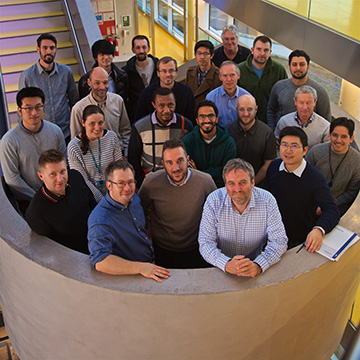![]()
Artist’s impression of a NANF guiding light. [Image: Optoelectronics Research Centre]
Over the past 50 years, fiber optics has supported a myriad technological revolutions—not the least being the broadband internet. But decades of R&D have the solid-glass light guides operating right up against their fundamental physical limits.
Researchers at the University of Southampton, U.K., have now developed hollow, air-filled fibers that they say overcome the main limitations faced by solid-core silica and offer record-low loss at three technologically significant spectral wavelengths in the 600-to-1100-nm range (Nat. Commun., doi: 10.1038/s41467-020-19910-7).
Hollow victory
In addition to being the bedrock of modern telecommunications, fiber optics has profoundly impacted industrial manufacturing, metrology, medical endoscopy, structural sensing and more. But the technology has come a long way in half a century, and in many applications silica optical fibers have hit a fundamental wall—the Rayleigh scattering limit.
This scattering, which places a hard boundary on, for example, the maximum data capacity or optical intensity that can travel through fiber, is caused by the interaction of light with glass that forms the fiber core. To skirt this limitation, researchers at Southampton’s Optoelectronics Research Centre (ORC), including OSA member Francesco Poletti, turned to a different kind of fiber—one that wasn’t based on solid silica.
Hollow-core fibers have numerous benefits over their solid counterparts, Poletti explains. They exploit the ultra-low Rayleigh scattering of air, as well as suppress nonlinear effects, increase the damage threshold and reduce latency. Moreover, he says, guiding light through air rather than glass produces fibers that are less sensitive to external temperatures and ionizing radiation.
One such design, the hollow-core nested antiresonant nodeless fiber (NANF)—previously developed by ORC researchers through the European Research Council project LightPipe and first reported by Poletti in Optics Express in 2014—has gained traction in recent years. In this design, smaller, nested tubes are arranged around a core of air, which increases the number of light-confining air–glass interfaces.
Shifting to shorter wavelengths

The hollow-core fiber group at the University of Southampton, Optoelectronics Research Centre. [Image: Optoelectronics Research Centre]
In the current work, the ORC team optimized these hollow fibers for operation at wavelengths ranging from the visible (660 nm) to the high-power-laser wavelengths around 1060 nm. This spectral range, explains Poletti, is technologically important for applications such as quantum communications, short-reach data transmission from VCSELs and laser power delivery.
In addition, says Poletti, the NANFs reported by his team also offer a pure spatial single-mode propagation, which helps to maintain or even improve the brightness of launched laser light—despite a three-to-fivefold larger core diameter than equivalent solid-core fibers.
“This has the potential to guide light with record-low loss at the speed of light in vacuum,” Poletti says, “and to transmit it undistorted, in a single transversal mode, at peak intensities that would destroy any conventional glass fiber, and which could represent the future of data-transmission and laser-power delivery.”
Beating the loss limit of glass
To fabricate their hollow fibers, the Southampton researchers used the stack, fuse and draw method, taking advantage of selective pressure differentials during the draw to control the final fiber geometry. The result was three different fibers designed to operate at 660 nm, 850 nm and 1064 nm, which in tests, achieved respective losses of 2.85, 1.45 and 0.51 dB km−1 at those wavelengths.
To the best of their knowledge, the researchers write, these ultra-low losses represent a new record for hollow-core fibers, as well as an improvement over all-solid glass fibers.
What is perhaps more exciting than these reportedly record-low results, Poletti notes, is that there’s plenty of room for improvement. “We think there is considerable scope for further enhancing the optical performance of our NANFs at all operational wavelengths of interest,” he says. “We are committed to try and demonstrate fibers with lower loss than achievable in a solid-core fiber across the electromagnetic spectrum.”
